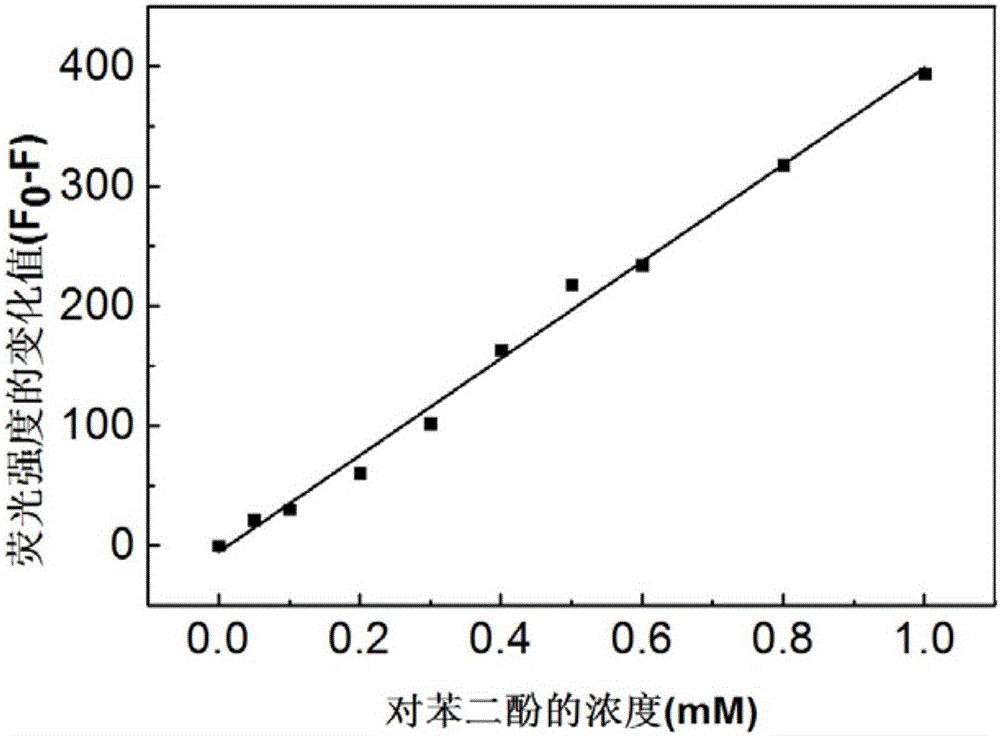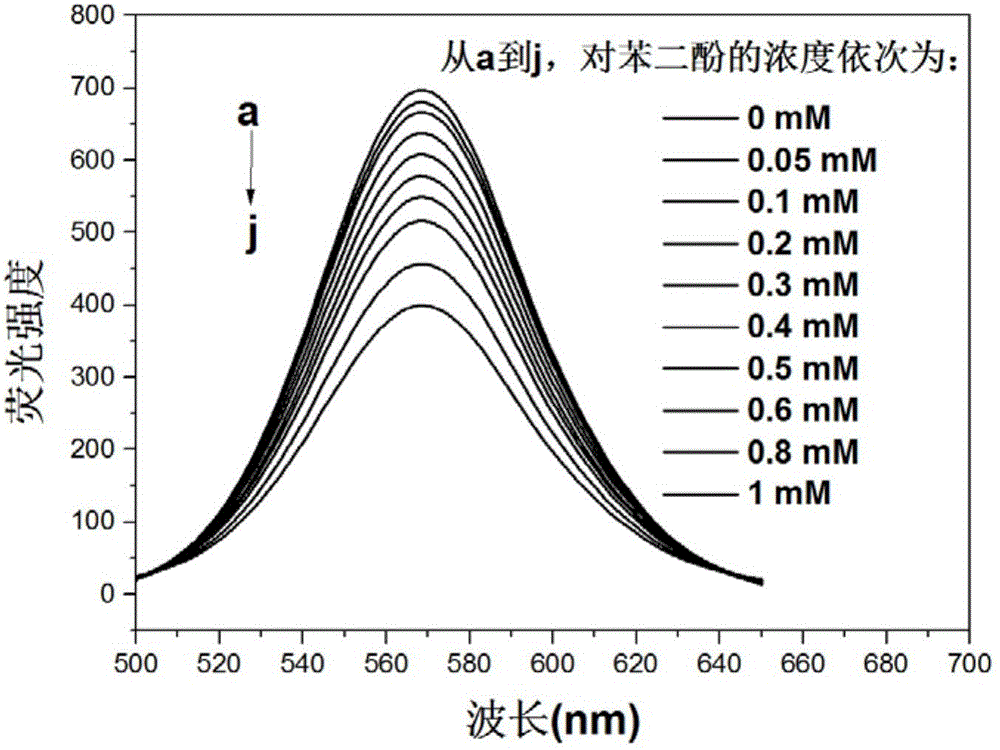Method for detecting hydroquinone on basis of magnetic quantum dots
A technology of hydroquinone and quantum dots, applied in the field of fluorescence analysis and detection, to achieve the effect of exempting the sample pretreatment process, detection economy, and low cost
- Summary
- Abstract
- Description
- Claims
- Application Information
AI Technical Summary
Problems solved by technology
Method used
Image
Examples
Embodiment 1
[0032] Embodiment 1: Select CdTe and Fe 3 o 4 The composite magnetic quantum dots detect the concentration of hydroquinone, and the specific operation steps are as follows:
[0033] (1) Preparation of magnetic quantum dots:
[0034] Magnetic Fe 3 o 4 Add 1,6-hexanediamine solution dropwise to the nanoparticle solution to adjust the pH of the solution to 5.0. Take 5ml of the CdTe nanoparticle solution and disperse it in 95ml of ultrapure water to obtain a diluted CdTe nanoparticle solution. Then the magnetic Fe 3 o 4 The 1,6-hexamethylene diamine solution of nanoparticles was added to 45 ml of diluted CdTe nanoparticle solution, so that the ratio of magnetic nanoparticles to fluorescent nanoparticles in the solution was 1:3. Adjust the pH of the solution to 6.0, then heat the solution to 30°C, and react for one hour to obtain the magnetic fluorescent Fe 3 o 4 CdTe composite nanomaterials, i.e. magnetic quantum dots;
[0035] (2) Preparation of hydroquinone standard so...
Embodiment 2
[0040] Embodiment 2: Select CdSe / ZnS and Fe 3 o 4 The composite magnetic quantum dots detect the concentration of hydroquinone, and the specific operation steps are as follows:
[0041] (1) Preparation of magnetic quantum dots:
[0042] Magnetic Fe 3 o 4 Add 1,6-hexanediamine solution dropwise to the nanoparticle solution to adjust the pH of the solution to 5.0. Take 5ml of the CdSe / ZnS nanoparticle solution and disperse it in 95ml of ultrapure water to obtain a diluted CdSe / ZnS nanoparticle solution. Then the magnetic Fe 3 o 4 The 1,6-hexamethylenediamine solution of nanoparticles was added to 45 ml of diluted CdSe / ZnS nanoparticle solution, so that the ratio of magnetic nanoparticles to fluorescent nanoparticles in the solution was 1:3. Adjust the pH of the solution to 6.0, then heat the solution to 30°C, and react for one hour to obtain the magnetic fluorescent Fe 3 o 4 CdSe / ZnS composite nanomaterials, namely magnetic quantum dots;
[0043] (2) Preparation of hyd...
Embodiment 3
[0048] Embodiment 3: Select CdTe / CdS / ZnS and Fe 3 o 4 The composite magnetic quantum dots detect the concentration of hydroquinone, and the specific operation steps are as follows:
[0049] (1) Preparation of magnetic quantum dots:
[0050] Magnetic Fe 3 o 4 Add 1,6-hexanediamine solution dropwise to the nanoparticle solution to adjust the pH of the solution to 5.0. Take 5ml of the CdTe / CdS / ZnS nanoparticle solution and disperse it in 95ml of ultrapure water to obtain a diluted CdTe / CdS / ZnS nanoparticle solution. Then the magnetic Fe 3 o 4 The 1,6-hexamethylene diamine solution of nanoparticles was added to 45 ml of diluted CdTe / CdS / ZnS nanoparticle solution, so that the ratio of magnetic nanoparticles to fluorescent nanoparticles in the solution was 1:3. Adjust the pH of the solution to 6.0, then heat the solution to 30°C, and react for one hour to obtain the magnetic fluorescent Fe 3 o 4 CdTe / CdS / ZnS composite nanomaterials, namely magnetic quantum dots;
[0051] (...
PUM
| Property | Measurement | Unit |
|---|---|---|
| Wavelength | aaaaa | aaaaa |
| Emission peak | aaaaa | aaaaa |
Abstract
Description
Claims
Application Information
 Login to View More
Login to View More - R&D Engineer
- R&D Manager
- IP Professional
- Industry Leading Data Capabilities
- Powerful AI technology
- Patent DNA Extraction
Browse by: Latest US Patents, China's latest patents, Technical Efficacy Thesaurus, Application Domain, Technology Topic, Popular Technical Reports.
© 2024 PatSnap. All rights reserved.Legal|Privacy policy|Modern Slavery Act Transparency Statement|Sitemap|About US| Contact US: help@patsnap.com










